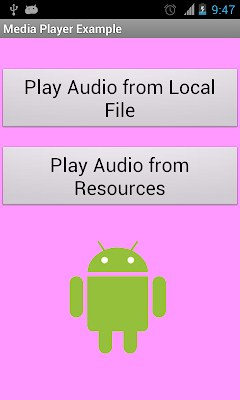Android Camera Preview
The camera is the most visible and most used sensor in an Android device. It is a selling point for most consumers, and the capabilities are getting better with each generation. Image-processing applications normally work on an image after it is taken, but other applications, such as augmented reality, utilize the camera in real-time with overlays.
There are two ways to access the camera from an application.The first is by declaring
an implicit intent.
The implicit intent launches the default camera interface:
Intent intent = new Intent("android.media.action.IMAGE_CAPTURE");
startActivity(intent);
The second way leverages the Camera class, which provides more flexibility in the settings.This creates a custom camera interface, which is the focus of the examples that follow. Camera hardware access requires explicit permission in the AndroidManifest XML file:
<uses-permission android:name="android.permission.CAMERA" />
This is implied in the following section.
Customizing the Camera
Control of the camera is abstracted into various components in the Android system:
CameraPreview.java CodeThere are two ways to access the camera from an application.The first is by declaring
an implicit intent.
The implicit intent launches the default camera interface:
Intent intent = new Intent("android.media.action.IMAGE_CAPTURE");
startActivity(intent);
The second way leverages the Camera class, which provides more flexibility in the settings.This creates a custom camera interface, which is the focus of the examples that follow. Camera hardware access requires explicit permission in the AndroidManifest XML file:
<uses-permission android:name="android.permission.CAMERA" />
This is implied in the following section.
Customizing the Camera
Control of the camera is abstracted into various components in the Android system:
- Camera class—Accesses the camera hardware
- Camera.Parameters class—Specifies the camera parameters such as picture size, picture quality, flash modes, and method to assign Global Positioning System (GPS) location
- Camera Preview methods—Sets the camera output display and toggles streaming video preview to the display
- SurfaceView class—Dedicates a drawing surface at the lowest level of the view hierarchy as a placeholder to display the camera preview
CameraPreviewActivity.java Code
package
android.example.camerapreview;
import
android.os.Bundle;
import
android.app.Activity;
import
android.view.Display;
import android.view.Menu;
import
android.view.SurfaceView;
import
android.view.Window;
public class
CameraPreviewActivity extends Activity {
private int viewWidth = 320;
private int viewHeight = 240;
private SurfaceView
cameraPreview;
@Override
public void
onCreate(Bundle savedInstanceState) {
super.onCreate(savedInstanceState);
requestWindowFeature(Window.FEATURE_NO_TITLE);
calculateDisplayDimensions();
cameraPreview = new
CameraPreview(this);
setContentView(cameraPreview);
}
private void
calculateDisplayDimensions() {
Display display =
getWindowManager().getDefaultDisplay();
viewWidth =
display.getWidth();
viewHeight =
display.getHeight();
}
}
package
android.example.camerapreview;
import android.app.Activity;
import android.os.Bundle;
import
android.content.Context;
import
android.hardware.Camera;
import
android.util.Log;
import
android.view.SurfaceHolder;
import
android.view.SurfaceView;
public class
CameraPreview extends SurfaceView implements
SurfaceHolder.Callback {
private
SurfaceHolder holder;
private Camera camera;
public
CameraPreview(Context context) {
super(context);
holder = getHolder();
holder.addCallback(this);
holder.setType(SurfaceHolder.SURFACE_TYPE_PUSH_BUFFERS);
}
//@Override
public void
surfaceChanged(SurfaceHolder holder2, int format, int w, int h) {
Camera.Parameters parameters = camera.getParameters();
parameters.setPreviewSize(w, h);
camera.setParameters(parameters);
camera.startPreview();
}
//@Override
public void
surfaceCreated(SurfaceHolder holder1) {
try {
camera = Camera.open();
camera.setPreviewDisplay(holder1);
}
catch (Exception e) {
Log.i("Exception surfaceCreated()", "e=" + e);
camera.release();
camera = null;
}
}
//@Override
public void
surfaceDestroyed(SurfaceHolder arg0) {
camera.stopPreview();
camera.release();
camera = null;
}
}
AndroidMainifest.xml Code
<manifest xmlns:android="http://schemas.android.com/apk/res/android"
package="android.example.camerapreview"
android:versionCode="1"
android:versionName="1.0"
>
<uses-sdk
android:minSdkVersion="8"
android:targetSdkVersion="15"
/>
<application
android:icon="@drawable/ic_launcher"
android:label="@string/app_name"
android:theme="@style/AppTheme"
>
<activity
android:name=".CameraPreviewActivity"
android:label="@string/title_activity_camera_preview"
>
<intent-filter>
<action android:name="android.intent.action.MAIN"
/>
<category android:name="android.intent.category.LAUNCHER" />
</intent-filter>
</activity>
</application>
<!-- We will request access to
the camera, saying we require a camera
of some sort but not one with autofocus
capability. -->
<uses-permission android:name="android.permission.CAMERA"/>
<uses-permission android:name="android.permission.INTERNET" />
<uses-feature android:name="android.hardware.camera" />
<uses-feature android:name="android.hardware.camera.autofocus" android:required="false" />
</manifest>
Download Android Camera Preview Example code
Android Control ควบคุมอุปกรณ์ต่างๆ ด้วย Android
สอนเขียน Android สอนเขียนโปรแกรม Android
http://androidcontrol.blogspot.com/2012/01/beginning-android-training-android.html
สอนเขียน Android สอนเขียนโปรแกรม Android แบบ Online
รับสอนเขียนโปรแกรม Android App สอนแบบ online สอนสด ตัวต่อตัว หรือ เป็นกลุ่ม ได้ทั่วประเทศ กำหนดเวลาเรียนได้
การเรียน Android App แบบ online สามารถกำหนดเวลาเรียน เองได้ ตามแต่ตกลงกัน
( รับสอน นอกสถานที่ แบบเป็น กลุ่ม ทั่วประเทศ )
แต่ละ Course ขึ้นอยู่กับพื้นฐานที่มี นะครับ
Course
1.JAVA Programming สำหรับผู้ที่ยังไม่มีพื้นฐานทางด้าน การเขียนโปรแกรม JAVA
เรียน 3-4 ครั้ง ครั้งละ 2 ชั่วโมง
2.Beginning Android Development เริ่มต้นการพัฒนาด้วย Android ( ต้องมีพื้นฐาน JAVA แล้ว )
เรียน 5-6 ครั้ง ครั้งละ 2 ชั่วโมง
เรียนจบคอร์สนี้ ก็สามารถทำ Application ได้แล้ว
3.Android Application สอนตามความต้องการในการเขียนโปรแกรม ใช้งานจริง เช่น โปรแกรมใช้งานด้านต่างๆ
ระยะเวลา และ ค่าเรียน ตามแต่ความยากง่ายของโปรแกรม ซึ่งอาจจะรวมสอน JAVA Programming ด้วยสำหรับผู้เริ่มต้นเลย
ดังนั้น ราคาสอน จะขึ้นอยู่กับ สเปคงาน
โปรแกรมที่ใช้ทำการเรียน Team Viewer Version ล่าสุด Version 8
Meeting ID จะแจ้งให้ก่อนเรียน ผ่านทาง email sms Line หรือ อื่นๆ ตามสะดวก
ใช้ Tab Meeting ใส่ Meeting ID และใส่ชื่อ
แล้ว Join Meeting
ติดต่อ amphancm@gmail.com
ติดต่อ amphancm@gmail.com


